Happy New Year everyone and thanks for helping to make 2019 a great start for my Forgotten Silver column here at Comic Book Daily! There is one question that I am often asked what I think is a good way to start 2020: “When does the Canadian Silver Age begin?” The answer to this question is not as simple as it may seem, because the answer is not entirely confirmed. For example, John Bell mentions in his book Invaders from the North that, “Despite the paucity of Canadian newsstand comics, some indigenous comic books were in evidence between 1957 and 1966” (p. 100). Typically, I have responded to such questions that the era begins sometime around 1960, probably with the publication of the first giveaway by Ganes Productions. However, new information uncovered early in 2019 put this into possible doubt (which I will return to below) and it is still not clear when was Ganes’ first comic was released.
What is clear is that Ganes Productions was the first significant Canadian comic publisher of the era. My research suggests that the company’s first comics may have been released as early as 1959 or 1960 and it is unclear what 1957 comic(s) Bell may be referring to in the abovementioned quote. Researching Ganes has proved to be a daunting task, but we do know that the company produced a dozens of comics from the 1960s into the early 1970s, predates the work of Owen McCarron and Robin Edmiston (Comic Page Features/Comic Book World) and was, at least for a time, the only company producing comic books in Canada. As such, Ganes Productions likely produced the first comic of the era. However, this is not a certainty.
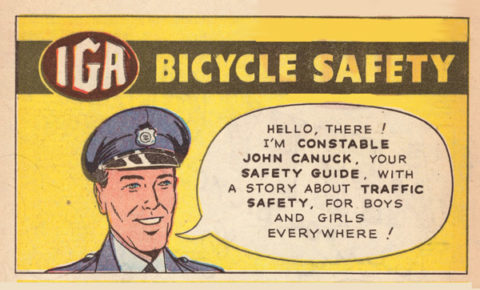
The comics that may have been released in 1959 or 1960 include IGA Safety Guide for Bicycle Riders, Across Canada with Red Cross Water Safety and Farm Machinery Safety Sense for Everyone. I do not own any of these comics and do not know if they are dated. I have been searching for copies for some time and the information that I have is insufficient. Until I can independently verify that the comics were released this early, this information should be taken with a grain of salt. There is ample evidence, however, that the farm safety comic has two variants: one was issued in conjunction with Manitoba Pool Elevators and another in conjunction with the Saskatchewan Wheat Pool. For now, these three comics are the best candidates for the first releases of the Canadian Silver Age.
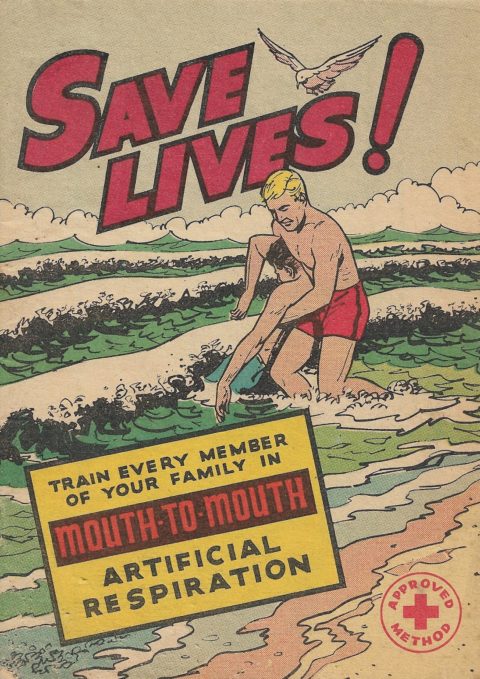
Robert MacMillan provides a very good overview of Ganes Productions on his website and includes a list of several comics that I have not been able to source physical or digital copies of (despite years of searching) that were published in 1960 and 1961. That said, I have been able to independently verify that Ganes Productions released several comics in 1962. The year saw Ganes release his mini-comic Save Lives! in conjunction with the Canadian Red Cross and Supertest Petroleum. The comic is a handy visual guide to how to perform mouth-to-mouth artificial respiration. The reason why this is a certainty is because the comic includes an indicia with the date.
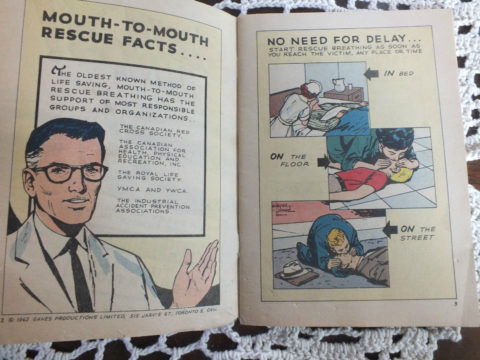
1962 also saw Ganes release two mini-comics in conjunction with the Ralston-Purina Company of Canada: Hockey Hints by “Toe” Blake and “Punch” Imlach’s Hockey Tips. Both mini-comics were included with boxes of Chex cereal and were the first of several sports comics produced by the company. The Toe Blake comic was released in both French and English versions and it is possible that this is true for the Punch Imlach comic too. Two variant covers of the Punch Imlach comic have been identified with different colouring. Like Save Lives, the Chex hockey minis include indicias and are dated 1962. As such, they are the earliest comics released by Ganes that I have been able to independently verify. Yet, as noted above, they are likely not the first comics Ganes published.
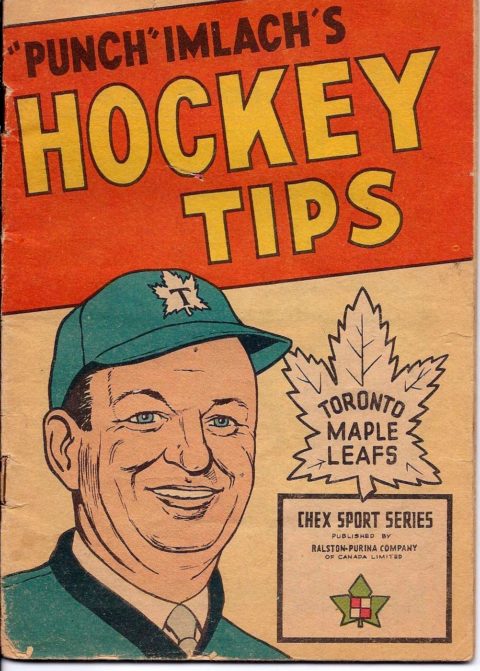
I realize that giveaway comics are not for everyone and when I mention that the early Canadian Silver Age is dominated by giveaways from Ganes Productions, I usually end up with a follow-up question that is along the lines of, “Okay, but what are the first non-giveaway comics from the Canadian Silver Age?” Until about a year ago, my answer tended to emphasize the emergence of Underground Comix around the country in the late 1960s, as well as literary avant-garde fare like Snore Comix or the comic fanzines that popped up in Ontario around the same time, such as Operation Missile by Derek Carter and Comic Canada by Terry Edwards.
All of this changed one day in early 2019 when I was contacted by noted Canadian Whites collector, Stephen Lipson, who had recently uncovered a stash of comics called The Story of Funny Money and hoped that I had more information about them. Stephen thought they might be from the 1970s and sent me several images of the comics (which I would later purchase from him). By the end of that day, both my understanding of the early Canadian Silver Age and the output of Canadian comics during the early 1960s had been rocked to the core. Here is, verbatim, what I wrote to him:
“Neil Carmichael was behind these. He was a significant member of the Ontario Social Credit Party and ran in several federal and provincial elections before he was ousted from the party in 1963 for being an anti-Semite. He was also ousted from the Nazi Party of Canada, from what I understand. Knowing the Carmichael connection, I suspect that these are some bonkers pamphlets. That said, are they dated? I would assume that he published them in the early-1960s, rather than during the 1970s. Another reason why I think this is because he suggests reading A.N. Field, who was a figure from the New Zealand Social Credit movement who died in 1963.”
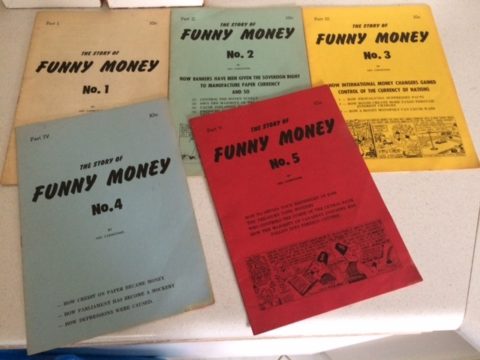
Mr. Lipson confirmed to me that the comics were undated and he assumed that they must be incredibly rare since he had never encountered them in all of his years collecting. Stephen’s knowledge of, and dedication towards, WECA-era Canadian comics is well-documented and I was quite sure that he had stumbled onto something of importance for my own research, regardless of the rarity or potential value of the comics themselves. When I received the comics towards the end of January 2019, I was shocked by what I saw and decided to squirrel them away and come back to them later, to the extent that I only informed Dan and Victor about them towards the end of the year. Now that 2020 has begun and this year is potentially the sixtieth anniversary of the beginning of the era, it is time to let the cat out of the bag. The existence of these comics made it possible that The Canadian Silver Age may have in fact began with a six-issue series of antisemitic comics created by a pro-fascist wannabee politician, rather than the informative giveaways produced by Ganes Productions.
So, when were these comics released? John Bell does not mention them in any of his books and they are not included in the John Bell Collection at Library and Archives Canada. The only academic reference that I have found is a short comment about Carmichael publishing antisemitic comics in Stanley Barrett’s 1989 book Is God a Racist? The Right Wing in Canada. Aurora (which allows researchers to search archive and library holdings worldwide) only has a listing for the first issue of the series, which is held at Library and Archives Canada and assumes that the series was published in 1959. The only other reference to the comics that I have found (academic or otherwise) are listings for the six issues at My Comic Shop, which suggests that the series is from 1961. Otherwise, the series has been erased from history. All of this led me to worry that the Canadian Silver Age kicked off with a series of antisemitic comics but, after some sleuthing, I no longer think this is the case. Allow me to explain.
The Social Credit Party of Canada was a populist, right-wing federal political party first established in 1935. It espoused social credit theories and monetary reform and was largely an outgrowth of the nascent provincial Alberta Social Credit Party, which dominated provincial politics from 1935-1971 (mostly under the leadership of Ernest Manning) and laid the groundwork for the emergence of the federal Reform Party in the late-1980s.
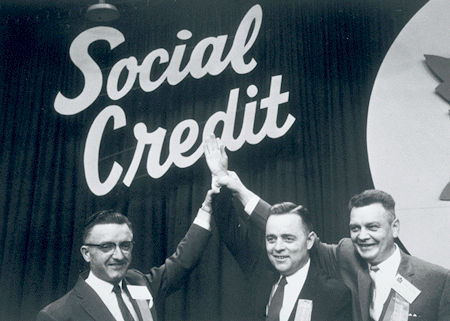
During the middle of the 20th Century, the federal Social Credit Party successfully achieved third party status on three separate occasions (1935, 1962 and 1963), approaching 12% of the popular vote in 1962 and 1963. The Socreds (as they were called) had their last hurrah in 1979 when they abstained in a vote on a motion of non-confidence to retaliate against Prime Minister Joe Clark’s refusal to grant them official party status (as then Socred leader Fabien Roy’s six seats in parliament gave them the balance of power in the fragile minority government). Clark lost the non-confidence vote, triggering the 1980 federal election and the Socreds would never elect another MP. The party last ran in the 1988 federal election and were essentially replaced by Ernest Manning’s son Preston’s new party on the national stage.
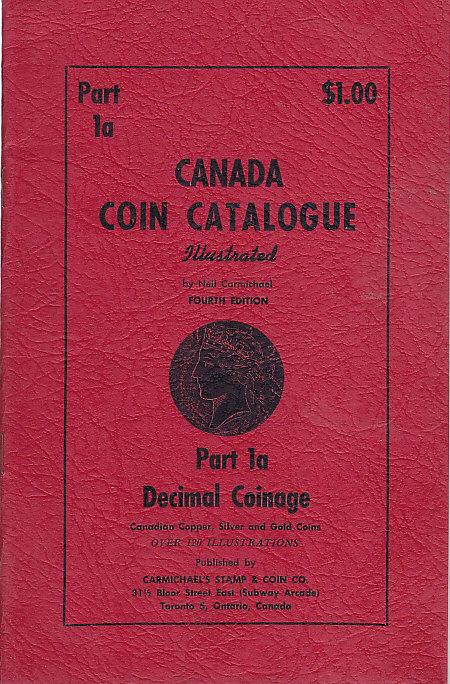
Neil Clifford Carmichael was a long-time member of the federal Social Credit Party when he manufactured the 1963 Ontario provincial party schism. Carmichael had run, unsuccessfully, in five separate federal elections between 1953-1963 in Peel, as well as St. Paul’s. Carmichael had been ousted by the federal party after the 1963 federal election because of antisemitic comments he had made in March 1963, claiming that the Rothschild family was attempting to purchase all of Canada’s mining interests as part of an international Jewish conspiracy. After the schism, Carmichael became the leader of the new Social Credit Action Party and ran unsuccessfully in the provincial election in September 1963.
By the end of 1964, Carmichael was accused of using his party’s headquarters as a meeting place and organizational space for the burgeoning neo-Nazi movement in Ontario, which included notorious figures David Stanley and William John Beattie. By 1965, Carmichael had been accused of trying to radicalize Ontario youth into becoming neo-Nazis along with Stanley. The negative publicity led to Carmichael and Beattie becoming adversaries. The two men clashed in the press as Beattie announced his formation of the Canadian Nazi Party, from which Carmichael was, apparently, excluded. Carmichael’s party did not run during the 1967 provincial election and by 1970 its remnants had been completely taken over by the fascist Edmund Burke Society and its leader, white supremacist Paul Fromm.
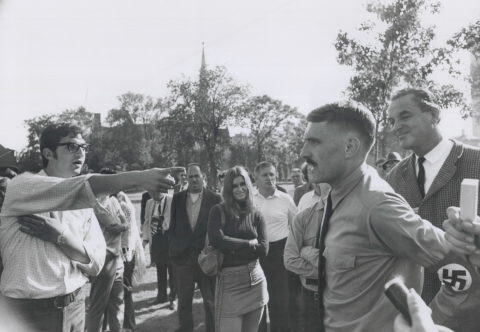
The Story of Funny Money is a revisionist history that proposes that greedy Jewish goldsmiths created the international monetary system as part of a grand conspiracy. The story follows the adventures of a fictional goldsmith named “Moolah” who is successful because of his greed, extortionary lending practices and fraudulent activities. Essentially, Moolah is presented as an example of an unscrupulous lender who presents traders with counterfeit paper money (aka “funny money”) in exchange for gold. Carmichael would lead us to believe this is the root of our economic system, which is in turn based on some kind of nefarious Jewish conspiracy. As the series goes on (with each issue presented as a chapter in Moolah’s story), the character becomes wealthier as he screws and gouges the unsuspecting dupes who choose to do business with him. The oversimplification and absurdity of Carmichael’s claims are obvious to anyone who has studied economics and as an economic anthropologist, I find this series to be nothing short of appalling.
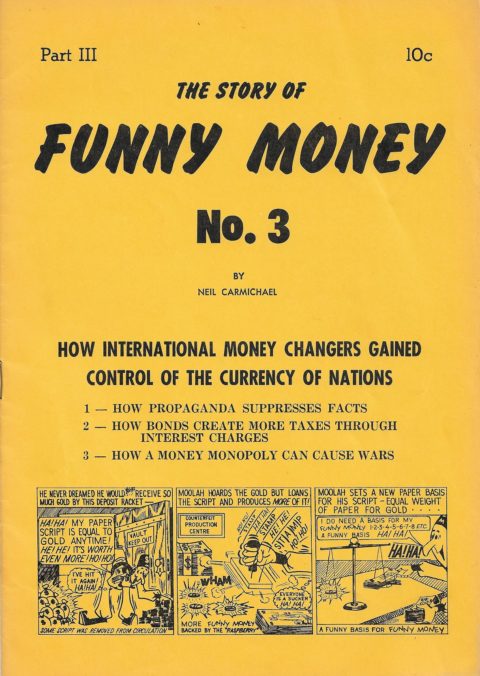
The comic strip portions of the series were drawn by Robert Wistow, whose biography on the inside front cover of the first issue states that he has a “diploma in Commercial Art” and once received a cash award for winning a contest sponsored by Disney. Other than this short biography, I can find no reference to the artist anywhere. In addition to the comic art (which makes up the bulk of each issue), every issue includes several pages of quotes taken out of context, panels recommending books (that are generally antisemitic or conspiratorial in nature) and Carmichael promoting conspiracy theories about the international monetary system under the guise of correcting Canada’s tax system via electing (presumably) Socred or Social Action politicians.
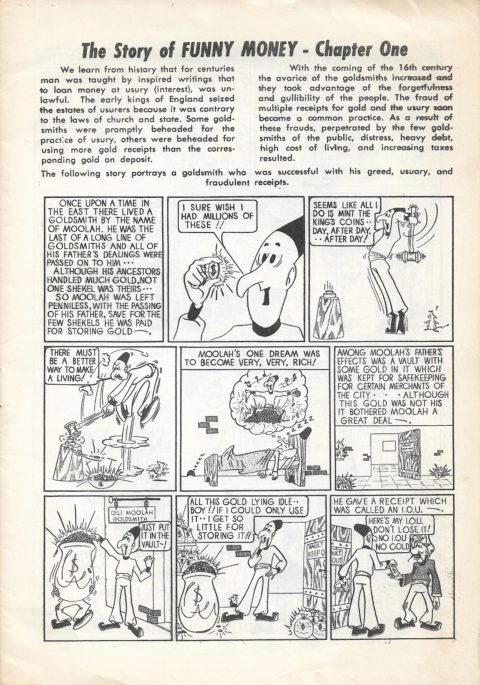
Dating these comics is difficult, but not impossible and I am now convinced that they were released by Carmichael after the formation of Social Credit Action. One clue comes from the fourth issue of the series, where one of Carmichael’s recommended books is All These Things by A. N. Field, which was published in 1963 by Omni Publications. As such, the issue could not have been published prior to 1963. Another clue is found on the back cover of the fifth issue, which quotes a parliamentary Hansard from December 17, 1963.
The best clue comes from the advertisements for “Social Credit Meetings Every Tuesday Night” on the back covers of each issue. The address for the meetings, 902 Yonge Street in Toronto, is the same address that Carmichael used as the headquarters for Social Credit Action and that he and Stanley used to host the meetings where they were accused of radicalizing youth. By process of elimination, the series was published no earlier than 1963, but before Carmichael was essentially forced out of Social Credit Action by 1965. For me, this is good news: it means that the Canadian Silver Age was not kicked off by antisemitic agitprop and that the informative giveaways published by Ganes Productions are likely what commences the era. If nothing else, Save Lives and the Chex minis predate Carmichael’s comics.
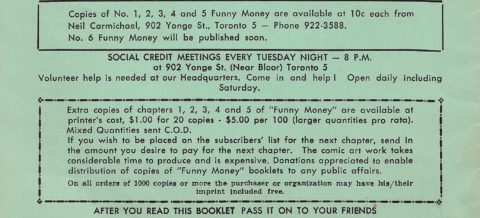
Perhaps that is the only good news about the existence of this comic series. Although it is impossible at this point for me to ascertain what the print run sizes were for the individual issues, the first issue of the series that I purchased from Mr. Lipson is the comic’s 9th printing and boasts that it already had a print run of 90,000 issues. This is a rather large circulation by today’s standards but is not necessarily the case when considered in historical context during the early to mid-1960s, when the circulation of print media was significantly higher than it is now. That said, knowing that Carmichael was able to publish so many copies of these comics begs more questions than answers. For me, the major question is why no one in the research or collector’s community had identified The Story of Funny Money before Mr. Lipson brought these to my attention.
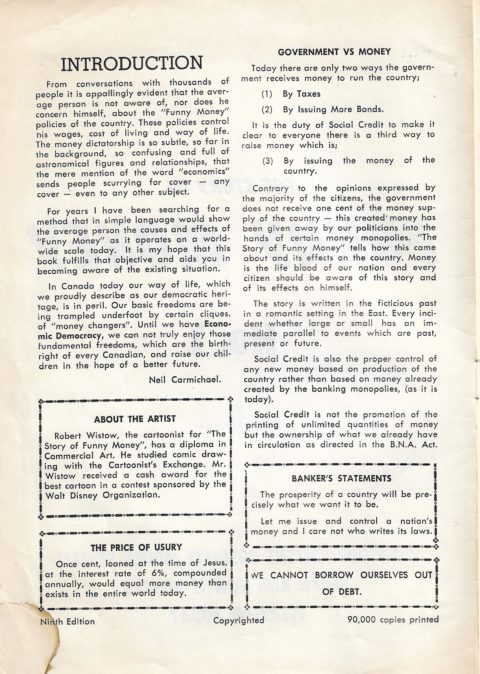
All in all, the Canadian Silver Age likely commences with the publication of a giveaway comic of some kind, which does not have the same cachet as how WECA began. Given the possibility that my own era of research may have started with antisemitic propaganda (which is thankfully not the case), I will happily celebrate that this era was kicked off by the publication of fun, educational giveaways every day of the week. Comics like The Story of Funny Money are dangerous cultural artifacts that should not be celebrated and are only worthy of discussion because rigorous historical analysis demands that research must examine all avenues of a subject, warts and all. In a collecting domain that prioritizes firsts, it is a good thing that The Story of Funny Money does not merit taking centre stage.

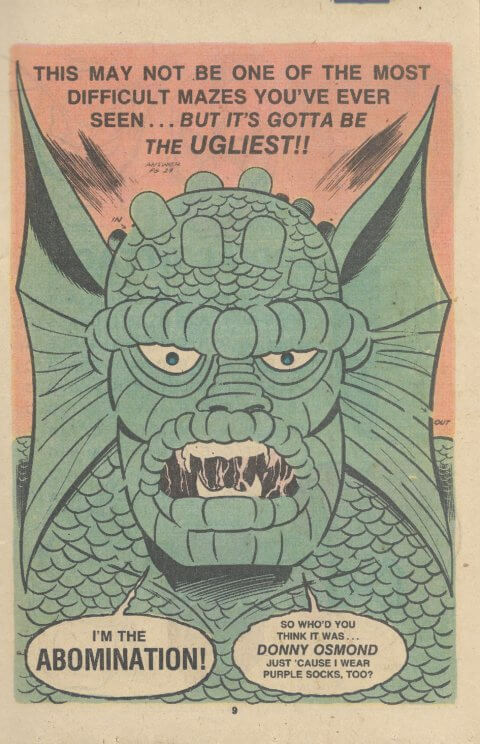
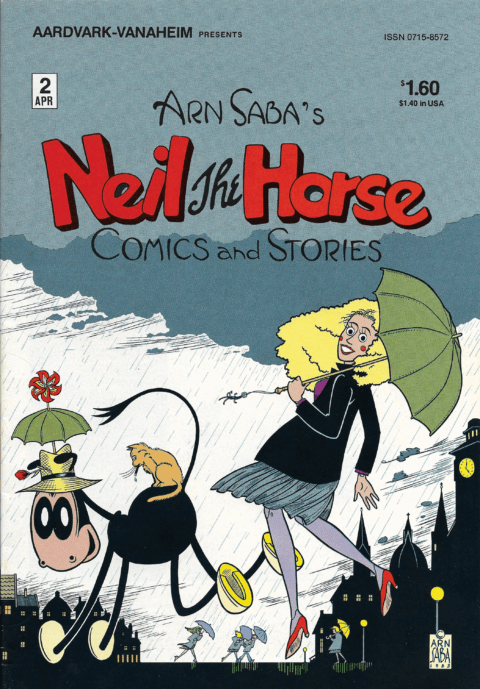
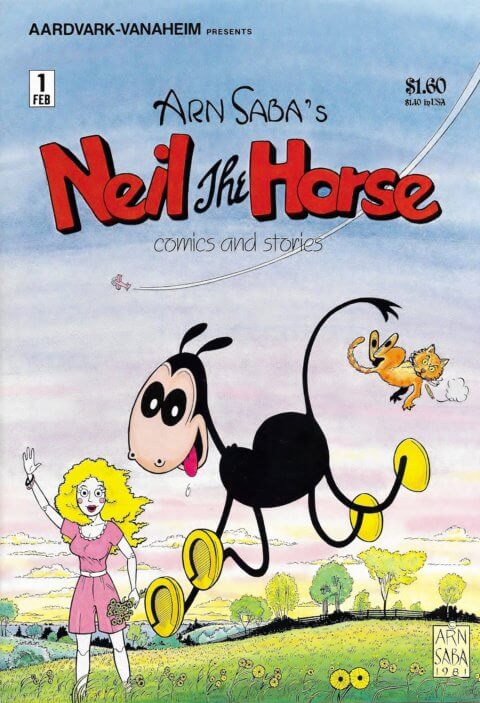
A couple of follow up points. First, Victor Marsillo and I discussed the possibility that the sixth issue of “The Story of Funny Money” may have never been released. It is possible that Carmichael abandoned the project as his ties to Stanley and Beattie became known in the press. Until a copy of the sixth issue surfaces, this remains a distinct possibility.
Second, the “Maclean’s” article by private investigator John Garrity that helped to expose Beattie is available online and does implicate Carmichael. Here is a link: https://archive.macleans.ca/article/1966/10/1/my-16-months-as-a-nazi
5
Interesting stuff here brian, but it reminds me of my old man’s favourite expression, “It takes all kinds to make a world…I just don’t want to meet some of the assholes.” The dreaded “Jewish conspiracy” has been touted by so many nutbars all around the world over the years, and I suppose it was inevitable that it would end up in Canada eventually. A few years back I used to play guitar with a guy whose wife, it turned out, held weekly meetings to discuss the evils of The Protocols of the Elders of Zion. When I pointed out to another member of the jam that these people were likely Nazis, he shrugged and said, “Well, apart from that they’re nice people.” It’s sad to think that such notions exist in our country and it’s fascinating to find it even crept into our favourite form of pop culture. You continue to amaze and educate with your monthly posts and I look forward to many more to come…even the creepy ones.
cheers, mel
Thanks for your comment, mel. I agree that it is sad that such notions exist in our country and was disheartened to find these sentiments among the Canadian comics that I mostly adore. It’s even more worrisome that such sentiments have been increasing again in Canada and that groups like Soldiers of Odin have attempted to infiltrate places like the Legion. I promise that next month I will offer something more pleasant.